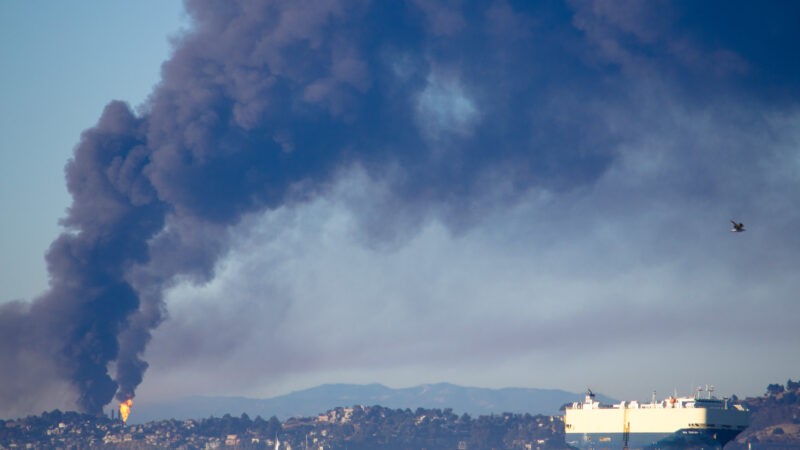
A 2012 explosion at the Chevron refinery in Richmond, California, nearly killed a dozen workers who got out just in time, and sickened 15,000 residents. “Chevron refinery fire” by Jonas Bengtsson, CC BY 2.0
The sky went black with smoke, flames lit up the night, government ignored obvious warning signs and catastrophe ensued. These are, yes, tropes from the movies. Horrifically, however, these scenes are also reality in refinery fenceline communities. And now there are zombies—California’s rulemaking processes have become infected by secret settlement agreements with the oil industry that send agencies uncritically marching towards rollbacks of critical safety worker and community safety regulations.
by Kerry Guerin, Staff Attorney
On August 6, 2012, the Chevron Richmond Refinery exploded. A fire sent a black plume over Richmond and 15,000 residents to seek medical treatment, with 19 worker injuries. Later investigation by the U.S. Chemical Safety Board revealed the incident may have been preventable, if only refinery management had heeded the warnings of on-site workers and replaced a failing stretch of pipe. In response, the community mobilized, and more than 2,500 people marched through Richmond to the refinery gates to protest the refinery’s dangerous presence in the community; and Chevron-backed candidates got trounced in the next local election. And ever since the 2012 refinery fire, CBE has been organizing in Richmond under its Beyond Chevron campaign.
Public outcry surrounding the fire led Governor Jerry Brown to form the Interagency Refinery Safety Task Force for the purpose of developing regulations to reduce the risk of an accident like the Chevron Richmond fire ever happening again. Over the next five years, representatives from federal, state and local government on the Task Force led a robust study of these risks and regulatory responses. The Task Force’s process included public and stakeholder engagement, including communities, workers and industry.
The resulting Process Safety Management (“PSM”) rules in 2017 adopted at CalOSHA and CalEPA were the strongest refinery safety rules in the country at the time. It was a win for everyone – workers and communities would be kept safer, consumers would be protected from price spikes following explosions that suddenly crunched refinery supply, and refineries themselves would face fewer expensive major incidents.
The oil lobby didn’t see it that way. In 2017, industry sued to block the rules, and seven years later California folded. In exchange for the oil industry dropping its lawsuit, CalOSHA and CalEPA agreed in the shadows to copy-and-paste its settlement agreement with industry into rulemaking processes. The proposed regulations are disastrous, weakening refinery safety measures and endangering workers and communities, all to industry’s gain.
While the agreement acknowledges it does not guarantee the agencies will adopt such rules as final, failing to do so would allow the oil industry to sue all over again. Seven years of deep-pocketed litigation and the threat for it to resume should agencies deviate from industry’s instructions spell out the writing on the wall – CalEPA and CalOSHA are ambling uncritically ever since getting bit by industry in court.
This is zombie rulemaking, and we marvel (and object!) in horror as agencies march forward toward these final rules.
Given that the amendments were drafted in boardrooms and backrooms, agencies are naturally having a hard time defending the proposed changes. When refinery workers questioned the logic behind various changes that threaten their safety, agency representatives have been unable to provide substantive defenses, offering instead “just that it came out of the litigation.”
This is not how rules are made. Agencies like CalOSHA and CalEPA are charged with adopting rules that protect workers, the environment, and communities. What we see now in 2025 is a far cry from the 2017 PSM Rules which were a model for rulemaking, with years of expertise from agencies, stakeholders and the public. Instead, industry simply scared the state into doing its bidding by litigation and settlement agreement.
Meanwhile, on October 2, 2025, another Chevron refinery caught fire, this time with an overnight blaze in El Segundo. Whereas the U.S. Chemical Safety Board was the key investigator in the Chevron Richmond fire in 2012, in this era of federal agency slashing CSB isn’t here to repeat the feat. Fenceline communities are now more vulnerable to refinery dangers than we’ve been in decades.
Every year since the 2012 fire, there has been a major incident involving a fire or release at a California refinery. That annual fact underscores that we have further to go yet in regulating refinery operations for the safety of workers and community.
To that end, CBE and allies urge CalEPA and CalOSHA to pause these rulemaking processes and incorporate lessons learned from the Chevron El Segundo fire.
As new refinery dangers become more apparent with every incident, CalEPA and CalOSHA cannot adopt industry’s rules and uphold their duty to the public at the same time.
Whether the state will be brave enough to stand up to the monster is yet to be seen. It may be on communities and workers to keep zombies to fiction and out of rulemaking, but it is a fight worth fighting when the stakes are apocalyptic.
